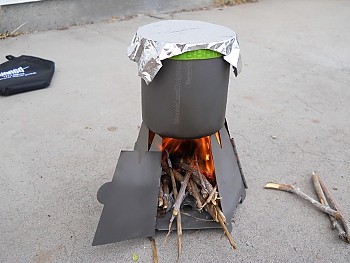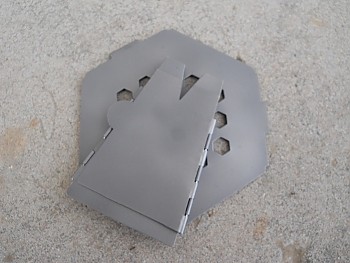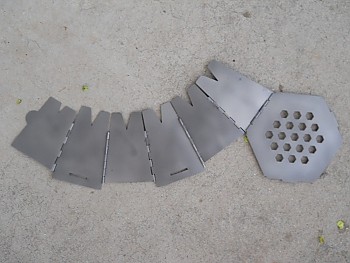Vargo Hexagon Wood Stove Titanium

In my testing, the Vargo Hexagon wood stove boils two cups of water almost as fast as a canister stove. Setup is intuitive, and since there’s no fuel to bring, the Vargo is a lighter option than many stoves. (Also, in the right locations, you’ll never run out of fuel.)
In areas where usable wood is plentiful and fire restrictions allow, the Hexagon stove is good choice, unless the menu calls for a stove with precise temperature control. The stove’s design just does not allow easily-made adjustments to heat output.

Vargo Hexagon boiling water in a 475 ml pot.
Best For: 1-2 people, below tree-line trips of any length, where fire restrictions allow. Freezer-bag cooking, and simple soups, stews, and pastas. Any trips outside of winter where speed is not the utmost concern.
Pros
-
Compact: Folds down to under ½” thick
-
Light: weighs a hair more than 4 ounces
-
Sets up in less than 10 seconds
-
Allows a lighter pack by sourcing cooking fuel from the campsite
Cons
- Temperature control is difficult
-
Collects soot, making cleanup an infrequent, but messy chore
-
Can be unstable when used with pots over 2 liters
-
Can deposit considerable soot on cooking pots
-
Requires having wood along one’s route of travel, or at campsite
-
Demands attention during operation: wood must be fed in fairly often
- Can develop hot-spots with smaller pots
Setup
The most convenient aspect about setting up the Vargo Hexagon is that there is only one piece to take out of the storage bag, unfold, and lock together. There is only one way to situate it, and no assembly required. This is different from many stove designs, which often require screwing multiple components together in a very certain configuration.
The Hexagon’s design is also ingenious in that it incorporates a windscreen, preventing the user from having to pack one in or improvise one in camp.
Vargo Hexagon collapsed for packing.

Vargo Hexagon stove expanded.
Flame Control
If you want precise temperature control, there are other stoves with more control than the Vargo Hexagon (or any other wood-burning stove, for that matter). This is not to say that a minimal, simmer-level flame isn't possible with the Hexagon, but that it requires constantly hand-feeding small sticks into the stove as long as simmering is desired.
The Hexagon stove works best—most efficiently—when its access door is opened briefly, and only to shove in a another handful of small twigs; this method allows the heat-focusing conical design to conserve as many BTUs as possible. Heat output can be adjusted though feeding in smaller sticks, feeding in sticks less frequently, or leaving the access door open. These three factors make it very difficult to operate the stove with a less-than-optimal fuel load and produce a consistent heat output.
Wind has little effect on the stove’s performance: with a pot on top, the Hexagon is nearly impervious to all but the biggest blows, and even then it just makes the fire burn hotter. The stoves' floor is raised off the ground about a half inch, elevated by little legs at each corner. This floor is grated, allowing oxygen in and ash out.

Vargo Hexagon, inverted to show the legs and grated base.
It may be that with the right stiff wind the stove could be stoked hotter as an air current rushes underneath, but I still generally like to keep my stoves and fires sheltered from the wind if, as in this case, only to keep the potential for fly-away embers to a minimum.
Boil Time
First off, there is a learning curve to getting fast boil times using this stove. The first time I fired it up, it took about nine minutes to get two cups of cool water boiling. One must learn both the ideal amount of fuel to put in, and the correct intervals at which to add it. Other variables come into play as well, like the type of wood and its moisture content.
Depending on your experiences building fires, the learning curve for this stove varies; it took me a few pots of water before I got everything dialed in. Subsequently, I have averaged a 7 minute, 25 second boil time for two cups of 55°F water.
I conducted my boil tests with a covered Mountain Laurel Designs 475 ml titanium pot, a squat, stable pot about as tall as it is around. I also attempted to use another pot I have, a 1L Primus EtaPower pot, with this stove, but the Primus pot has a flux ring welded to it which does not mate at all with the stove’s pot stand, so be aware of this if your pot has a similar design. In my opinion, a 1L pot is likely ideal for a stove of this size.
Fuel Efficiency
There are so many variables—type of wood, size of the piece of wood, degree of degradation of the wood, moisture in the wood, moisture in the air, elevation, etc.—at play when trying to determine the “efficiency” of this stove that the results shown here are more of a starting point than objective answers . A person operating this stove on the Olympic Peninsula will experience different boil times than will someone using it on the Florida Trail.
Here in western Colorado, I usually gather juniper (cedar) sticks for my fires, and there may be no better-smelling wood to burn. Once I dialed in my technique I averaged about three ounces of sticks (about six handfuls) for two cups of water.
In order to get an idea of how much wood is used to boil a given amount of water, I gathered a bunch of very small sticks—under a quarter inch in diameter—into a pile and weighed them. I then weighed the pile remaining after using the stove, and calculated the difference.
Since there is no fuel to carry, calculating fuel efficiency is really only useful for knowing how many handfuls of twigs to keep at the ready.
Cooking
The pot stand created by the stove is approximately 3-1/2 inches across, and worked well with my 475 ml titanium pot. The pot fit fine on the stove, and while I’m sure the stove is stout enough to support as much as a couple of gallons of water, I wouldn’t want to try to balance a pot larger than three liters on there. I tried the a two liter pot, and though it worked, I had to be careful to balance it just so. The problem is not the surface itself, for that is machined precisely, flat and stable; it is merely a function of the size of the stove.
The Hexagon worked well for soups and pastas. With no real flame control, it’s impractical for frying a pancake or searing fish or meat. It works adequately for simmering thick soups and pastas in the 475mL pot, and my sense is that it would work even better with a 1 liter and 2 liter pot.
With my smallish pot, hot spots happened occasionally, and I dealt with them by quickly dumping heat from the stove by opening the access door a measure. This is easily done with one hand while stirring.
I tried frying a pancake over the Hexagon at home, in the back yard. It worked, but not well, or with ease. Even after I got the flame to a level I thought might work, I essentially had to overcook the pancake, drying it severely, because of the uneven flame pattern, which left several raw spots in the cake while the rest was already cooked.
Packability
Made entirely of titanium, the stove dissipates heat quickly after the fire is extinguished: you can pick the stove up and begin to fold it just minutes after quenching the coals. When folded, the stove creates a neat little hexagonal shape a little more than five inches across the flats, and just under a half inch wide. It’s truly beautiful engineering.
Vargo includes a well-made nylon bag in which to store the stove. The bag is a matching hexagonal shape, with the top half able to open like a mouth, a fat seam of hook-and-loop fastener holding it shut.
The case does a stand-up job of keeping all the grit and grime built-up that’s on the stove, isolated with the stove. It slips away into anywhere in my pack, though I like to keep it in a side pocket, usually behind a water bottle, for easy accessibility.
Durability
From the moment I picked up the Vargo Hexagon I knew I wasn’t going to have to baby it: it is made of stiff, inflexible titanium, uses only pinned hinges to attach to the sections, and these hinges are rolled from the same titanium sheet as the hinged sections. Simple.
The metal is so thick that I have no reservations against quenching the fire while still in the stove. When I first tried that, the titanium showed no signs of warping and hasn’t since.
The bottom of the stove is grated, so water and ash drain out of the bottom, while larger unburned material remains in the stove. The stove is super easy to clean as well, requiring no special care; just a little water, soap, and a stiff-bristled brush every so often.
Conclusion
I’d like to make an ethical point here. The energy costs that go into producing and transporting traditionally-used stove fuels like white gas and iso-butane canisters are substantial. I use an efficient, wood-fired stove because it is more agreeable to my personal ethic. Using locally-sourced ground fuel rather than buying and packing in fuel is a more sustainable choice.
If there are no fire restrictions in the area you’re traveling, and you’re camping in an area with an abundance of usable twigs, and making meals that don't require low heat, there are few reasons to not use this stove. You need to be comfortable building fires, and be in an area with dry wood available.
When fuel weights are added into the equation, the Vargo Hexagon wood stove is a lighter option than all but the most minimal esbit or alcohol stove setups, and it’s faster and more capable than those options anyway.
It’s not the best choice for big groups due to its smallish size, but it’s that size which makes it fuel efficient and ideal for one to two people, boil water-type meals.
If you’re planning a thru-hike or really any backpacking trip longer than a week, and you’re traveling through forest, you should seriously consider the Vargo Titanium Hexagon stove.
Testing Notes
I cooked for a total of approximately 13 hours over the course of myriad backpacking trips and day hikes, in the mountains and canyons surrounding Grand Junction, Colorado. I tested during late summer, dubbed the “monsoon” season by locals due to the unusually high rainfall received in just a couple months’ time. (This Midwest-raised boy says it didn’t really rain all that much…)
The stove was operated at elevations ranging from 4,200 to 8,000 feet, in temperatures ranging from 55 to 100°F.
I burned mostly juniper twigs and some pinyon pine and scrub oak. The best-sized twigs for fuel seem to be around three inches long, and around a quarter inch in diameter, stripped of bark.
Source: received for testing via the Trailspace Review Corps
Price Paid: Sample provided by Vargo Designs for testing and review
A great pocket wood burning stove ideal for boiling water and simple cooking. Well thought out design means a fire is burning in a very short space of time. It can also be used with an alchohol burner making it a versatile source of heat.
Pros
- Versatility
- Packed size
- Weight (especially the ti version)
- Ease of use
Cons
- Moving parts could compromise the longevity of the stove
- Ti version is an expensive way to save few grams
There are many wood burning stoves on the market as individuals around the globe think they have discovered the 'holy grail' of wood burning stove design. The market is saturated; especially now that Chinese and Russian imitations are flooding the market. The Vargo Hex one has been around for a while and there are plenty of good reasons it has managed to survive competition, especially those cheap imitations.
The stove is incredibly well designed. The shape and dimensions funnel heat to the base of the pot and generate a lot of heat. Although not a 'gasifier', very little combustible material is wasted. Unlike snap together stoves it is incredibly easy to set up and this is where this stove beats the competition in my opinion. The last thing I want to do after an exhausting day's walking is battle with several parts that need to be clicked together. If very small pots/mugs are used, place a couple of thin tent pegs across the middle for support.
The stove is strong enough to take a variety of pots. There are two versions, though I think the ti version is quite an expensive way of saving a few grams. Carry a little less water in your canteen and you will still weigh the same and be richer for it. Once a pack has been filled I doubt you'd notice the difference between the two.
The stove is very portable. It folds flat and comes with a handy carry pouch which is useful for packing and storing the stove so other items do not get sooty or become scratched. It will fit inside many larger pots or can be slipped into a rucksack pocket, etc.
Cooking on a fire is not for everyone. With this in mind, the stove works really well with any alcohol burner you care to put inside it along with a simple wind shield. Vargo have designed a specific burner to go with the Hex which guarantees the unit is the correct distance from the base of the pot used but I think this is unnecessary (I used a homemade aluminium can burner on a few days walking along the South Downs and I was surprised at how efficient and quick it was to bring a full MSR Titan pot to a rolling boil when placed inside the Hex and surrounded by a windshield. I know there a many of you out there who like to watch Hiram Cook boil water on YouTube and he talks about the 'sweet spot'. I am sure he is right but the difference is negligible).
It is difficult to find fault with this stove. My only thoughts are that whilst the hinged panels mean it is very quick to assemble there is the possibility this may compromise the longevity of the stove as fatigue from heavy use where the stove is constantly heating and cooling may cause a hinge to fail but I think this is unlikely.
In summary, this is a great stove that is light, versatile, easy and fun to use which, if you buy the stainless steel version won't break the bank. Don't be tempted by cheap imitations, you get what you pay for and it is well worth it. The ti version is equally good and I have one myself but it is a luxury not a necessity.
Source: bought it new
Price Paid: £59.99
Perfect for my outdoor cooking. Very light and tiny when packed, but has cooking power.
Pros
- Small
- Light
- Good cooking (heat) power
Cons
- Needs a little tweak to keep it in shape
I bought this little stove for my outdoor cycling trips. I needed something really tiny and light because I carry only a small backpack (14 litres Osprey) for even a week-long trips where I keep all my stuff.
I was very surprised after I have tested this stove. It needs only several wood pieces to cook a dinner and it has enough power to boil water for soups, tea etc. I even cooked potatoes (25 minutes in boiling water on it).
For me cooking is fun. I enjoy it as a part of my trips. This little devil is a great tool for me. Perfect.
TIP: I tweaked this stove a little with an office paper pin which I used to fix the stove in a cooking postiion. Without this tweak the stove tends to be a little bit unstable.
Source: bought it new
Price Paid: 49 dollars
Almost works.
Pros
- Titanium strength
- No loose parts
Cons
- It doesn’t burn wood well
Fire requires three things: heat (ignition), fuel, and oxygen.
This stove does not draw enough air to stay burning.
On a six-day backpack trip on the Ice Age Trail this was my main stove. Even with the door open I spent the whole time blowing on it to keep the flame alive. Using split dry hardwood this would not burn well, the wood at the side furthest from the door just sat. If I closed the door everything went out. I even raised it on stones hoping air would come up and fan the flames, nope.
Luckily I packed Esbit cubes just in case it rained.
Source: bought it new
Your Review
Where to Buy
You May Like
Specs
| Price |
MSRP: $59.95 Current Retail: $59.95 Historic Range: $41.97-$67.99 Reviewers Paid: $49.00 |
| Weight |
4.1 oz |



